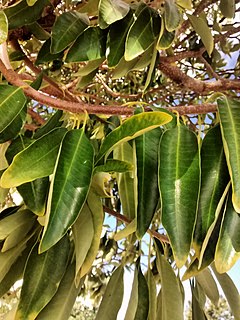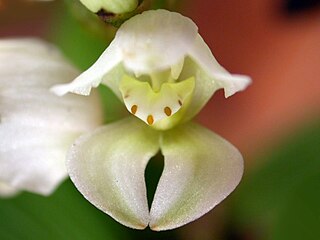Aspidosperma excelsum is a tree in the family Apocynaceae. It is native to Peru, Bolivia, Colombia, Venezuela, the Guianas, Panama, and Costa Rica.

Aspidosperma cylindrocarpon is a timber tree native to Brazil, Paraguay, Bolivia, and Peru. It is common in Atlantic Forest, Cerrado and Pantanal vegetation of Brazil. This plant is cited in Flora Brasiliensis by Carl Friedrich Philipp von Martius. In addition, it is useful for beekeeping.

Aspidosperma macrocarpon is a timber tree native to Brazil, Venezuela, Bolivia, Paraguay, and Peru. It is common in Cerrado vegetation. It has a self-supporting growth form with simple, broad leaves. This plant is cited in Flora Brasiliensis by Carl Friedrich Philipp von Martius, and it is useful for beekeeping. Individual plants can grow up to 25 m.

Aspidosperma parvifolium is a timber tree native to Brazil, which is typical of Atlantic Forest, Cerrado, Caatinga, and Pantanal vegetation. This plant is cited in Flora Brasiliensis by Carl Friedrich Philipp von Martius. In addition, it is useful for beekeeping.

Aspidosperma polyneuron is a timber tree native to Brazil, Colombia, Peru, Argentina, and Paraguay. It is common in Atlantic Forest vegetation. In addition, it is useful for beekeeping.
Aspidosperma ramiflorum is a timber tree native to Brazil and Bolivia.

Aspidosperma subincanum is a timber tree native to Brazil and Bolivia. It is common in Cerrado vegetation in Brazil. It was first described by Carl Friedrich Philipp von Martius in 1838.

Aspidosperma tomentosum is a timber tree native to Brazil, Bolivia, and Paraguay. It is common in of Cerrado vegetation in Brazil. It was first described by Carl Friedrich Philipp von Martius.

Aspidosperma australe is a timber tree native to Brazil, Argentina, Bolivia, and Paraguay.
Aspidosperma olivaceum is a timber tree native to SE Brazil. It is common in Atlantic Forest, Cerrado, Caatinga, and Pantanal vegetation.
Aspidosperma ulei is a timber tree native to Brazil, Venezuela, Colombia, Guyana, and Suriname.

Aechmea bromeliifolia is a bromeliad native to southern Mexico, Central America, Trinidad, and South America as far south as northern Argentina.

Aechmea nudicaulis is a bromeliad species in the genus Aechmea, which is often used as an ornamental plant. This species is native to Central America, the West Indies, central and southern Mexico, and northern and central South America.

Hypoxis decumbens is a species of plant in the Hypoxidaceae, considered by some authors to be included within the Liliaceae or Amaryllidaceae. The species is widespread across South America, Central America, Mexico, and the West Indies.
Thoracocarpus is a genus of plants first described as a genus in 1958. It contains only one known species, Thoracocarpus bissectus a hemiepiphytic vine. It is native to Costa Rica, Panama, Cuba, Trinidad and Tobago, and South America.

Eulophia alta is a species of orchid, known as the wild coco. It is widespread across tropical and subtropical parts of Africa, South America, Central America, Mexico and the West Indies, as well as the southeastern United States.

Govenia utriculata is a species of orchid. It is widespread across much of Latin America and the West Indies, from Mexico and Puerto Rico south to Argentina.
Euterpe catinga is a palm species in the genus Euterpe. It is found in forests of a dry, sandy soil and very peculiar vegetation, known as catinga forests in northern South America.

Cyclopogon elatus is a species of terrestrial orchids. It is widespread across much of Latin America from Mexico to Argentina, as well as in the West Indies and southern Florida.
Macroscepis is a genus of plants in the family Apocynaceae, first described as a genus in 1819. It is native to Latin America and the West Indies.












